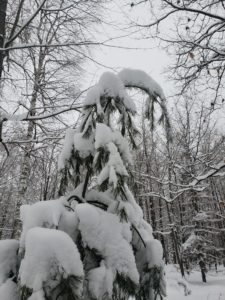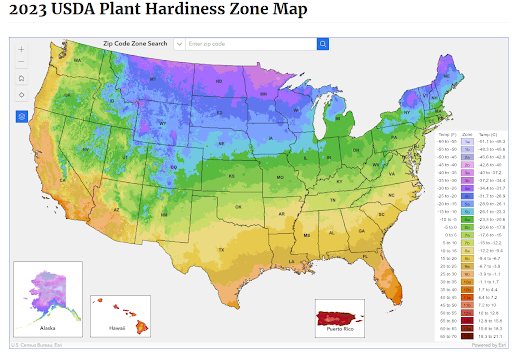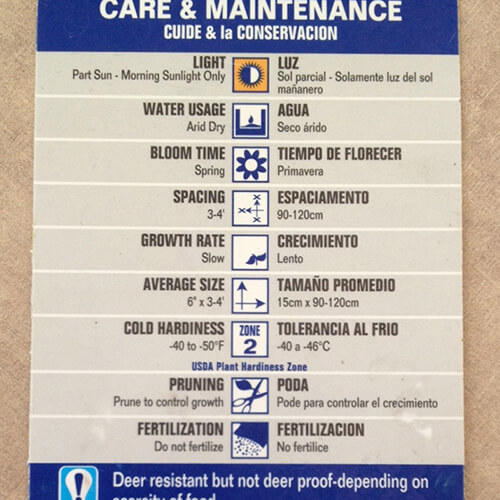Climate Ready Trees
How Does Climate Limit Trees?
Each season poses a unique threat to plants; cold, wind, and heat but heat is often the most limiting factor.
When planting a tree, you want to make sure that it can survive year- round and return. You don’t want to invest in a tree not adapted to the local climate that dies as soon as it snows or when the temperature hits 100.
What are Plant Hardiness Zones?
To guide growers when choosing what plants to buy and sell the US Department of Agriculture created a standard, Plant Hardiness Zones.
This is a way to know which plants will be able to survive cold temperatures in your area and return year after year.
Each area on the map is given a zone number from 1 to 13. The zones are based on the average annual minimum winter temperature. For example in Santa Rosa the average annual minimum is 0 to 5°F which is 7b. It could get colder then that but on average the coldest that it gets is 0°F.
Match Plant Zones to Hardiness Zones
Each plant in the store also gets a zone number. These numbers indicate what temperature that plant is able to survive at. For the plant tag to the left, it likes zone 8 which means that it doesn’t like it to get colder than 20°F and will likely die if it is below 10°F.
When shopping for plants you want to select a plant that fits in your zone. If you choose the plant to the left and you live in Santa Rosa the plant will not be able to survive year round.



Find Your Current Hardiness Zone
These are the current Plant Hardiness zones of New Mexico. Find your town and see what zone you are in. Do the average low temperatures sound right to you?

Find Your Future Hardiness Zone
The clmate is rapidly changing and zones are shifting. Future Plant Hardiness Zones have been modeled for the end of the century. Find your town and see what zone you will be in. When picking out a plant you want to make sure it is adapted to your current and future zone numbers.

Climate Ready Trees
To address the changing climate the State Forestry Department and many partners worked to develop a list of trees that are adapted to grow in cities now and for the next 100 years. These trees were scored to be adapted to changing temperatures, heat, cold, a variety of soil types, and drought conditions. These trees are matched to Plant Hardiness Zones of the future (shown above).
Find your future climate zone and then click on the list to see what trees are recommended for you!
Zone 7B/8A
Cities such as Las Vegas, Taos, Springer, Cimarron, Clayton, and Raton
Zone 8B
Cities such as Cloudcroft, Ruidoso, Capitan, Santa Fe, Clovis, and Tucumcari
Zone 9A
Cities such as Silver City, Carlsbad, Roswell, Socorro, and Albuquerque.
Zone 9B
Cities such as Las Cruces, T or C, and Alamogordo.
Albuquerque Specific List
List for Albuquerque with species divided for specific planting areas.
Starred species should be used more cautiously as they were not unanimously chosen by the panel.
Other 9A cities can use this list but it includes species that are adapted to the increased impervious surface and water runoff of ABQ
Climate Ready Tree Demonstration Sites
Apply to be a Climate Ready Demonstration Site and receive free trees!
Governmental entities such as cities, schools, counties, or non-profits that have public spaces that they own and are open to the public within New Mexico can apply. These sites will provide educational opportunities for the public and allow for observations on how Climate Ready Trees perform under local and regional conditions.
The Climate Ready Trees Program is designed to identify climate-adaptable tree species that can survive current conditions and climatic changes over the next century and introduce these species into our urban landscape.
Using climate modeling, The Nature Conservancy determined future climate zones for New Mexico, then a rigorous review protocol evaluated potential tree species’ adaptability and tolerances to urban and climate conditions. Now demonstration sites are needed to introduce these new species into the urban landscape and to inform both nursery growers and the public about these new species.
- Read more about Goals & Requirements for being a Climate Ready Demonstration Site.
- View the Monitoring Form.
- Tree Species available for Spring 2024: Chinese pistache, Lacebark elm, Ginkgo, Atlas cedar, Osage orange, and Texas red oak
